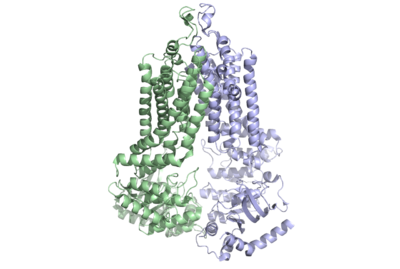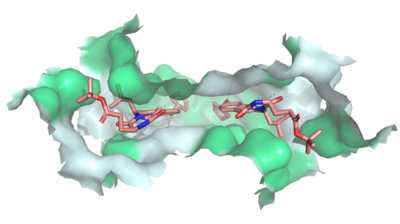Sandbox Reserved 1613
From Proteopedia
(Difference between revisions)
| Line 17: | Line 17: | ||
Multidrug Transporter ABCG2 is a <scene name='83/832937/Dimer/1'>dimer</scene> that consists of two [https://en.wikipedia.org/wiki/Cavity cavities] separated by a <scene name='83/832937/Leucine_plug/4'>leucine plug</scene>. Cavity 1 is a binding pocket open to the [https://en.wikipedia.org/wiki/Cytoplasm cytoplasm] and the inner leaflet of the plasma membrane. Its shape is suitable to bind flat, hydrophobic and polycyclic substrates.<ref name="Manolaridis">PMID:30405239</ref> Many of its amino acids residues form hydrophobic interactions with the bound substrate, as shown in green in '''Figure 1'''. Cavity 2 is located above the leucine plug. It is empty until a <scene name='83/832937/Atp_and_mg_bound_to_abcg2/4'>magnesium ion and ATP</scene> are bound to ABCG2.<ref name="Taylor">PMID:28554189</ref> Its <scene name='83/832937/Cysteine_disulfide_bridges/5'>inter- and intra-disulfides</scene> (yellow is inter- and intra-molecular disulfides, golden is intra-molecular only) promote the release of the substrate from the cavity into the extracellular space. | Multidrug Transporter ABCG2 is a <scene name='83/832937/Dimer/1'>dimer</scene> that consists of two [https://en.wikipedia.org/wiki/Cavity cavities] separated by a <scene name='83/832937/Leucine_plug/4'>leucine plug</scene>. Cavity 1 is a binding pocket open to the [https://en.wikipedia.org/wiki/Cytoplasm cytoplasm] and the inner leaflet of the plasma membrane. Its shape is suitable to bind flat, hydrophobic and polycyclic substrates.<ref name="Manolaridis">PMID:30405239</ref> Many of its amino acids residues form hydrophobic interactions with the bound substrate, as shown in green in '''Figure 1'''. Cavity 2 is located above the leucine plug. It is empty until a <scene name='83/832937/Atp_and_mg_bound_to_abcg2/4'>magnesium ion and ATP</scene> are bound to ABCG2.<ref name="Taylor">PMID:28554189</ref> Its <scene name='83/832937/Cysteine_disulfide_bridges/5'>inter- and intra-disulfides</scene> (yellow is inter- and intra-molecular disulfides, golden is intra-molecular only) promote the release of the substrate from the cavity into the extracellular space. | ||
One interesting feature of the NBD's is the fact that they remain in contact with one another even without a bound substrate. This makes the ABCG2 transporter unique and provides greater substrate specificity as the entrance to the transporter is not as globular as either ABCB1 or ABCC1. The entrance from the cytoplasm to the transporter is a [https://en.wikipedia.org/wiki/Hydrophobe hydrophobic] membrane entrance lined by <scene name='83/832939/Lining_of_entrance_of_nbd/1'>residues A397, V401, L405, L539, I543 and T547</scene> in both [https://en.wikipedia.org/wiki/Monomer monomers]. | One interesting feature of the NBD's is the fact that they remain in contact with one another even without a bound substrate. This makes the ABCG2 transporter unique and provides greater substrate specificity as the entrance to the transporter is not as globular as either ABCB1 or ABCC1. The entrance from the cytoplasm to the transporter is a [https://en.wikipedia.org/wiki/Hydrophobe hydrophobic] membrane entrance lined by <scene name='83/832939/Lining_of_entrance_of_nbd/1'>residues A397, V401, L405, L539, I543 and T547</scene> in both [https://en.wikipedia.org/wiki/Monomer monomers]. | ||
| - | Dimerization of ABCG2 was originally thought to be achieved with the help of the <scene name='83/832939/Disproved_dimerization_process/1'>406xxx410 structural motif</scene> in each of the two domains but Cryo-EM showed that the [https://en.wikipedia.org/wiki/Sequence_motif motifs] were on opposite sides of the protein. | + | Dimerization of ABCG2 was originally thought to be achieved with the help of the <scene name='83/832939/Disproved_dimerization_process/1'>406xxx410 structural motif</scene> in each of the two domains but Cryo-EM showed that the [https://en.wikipedia.org/wiki/Sequence_motif motifs] were on opposite sides of the protein.<ref name="Manolaridis" /> <ref name="Jackson">PMID:29610494</ref> |
| - | <ref name="Manolaridis" /> | + | |
| - | <ref name="Jackson">PMID:29610494</ref> | + | |
| Line 26: | Line 24: | ||
==Function== | ==Function== | ||
| - | ABCG2 transports a variety of <scene name='83/832939/Mz29/1'>substrates</scene>, particularly flat, hydrophobic, and/or polycylcic molecules. ABCG2 is found in multiple biological membranes, especially at blood barriers such as the | + | ABCG2 transports a variety of <scene name='83/832939/Mz29/1'>substrates</scene>, particularly flat, hydrophobic, and/or polycylcic molecules.<ref name="Jackson">PMID:29610494</ref> ABCG2 is found in multiple biological membranes, especially at blood barriers such as the [https://en.wikipedia.org/wiki/Blood brain barrier], [https://en.wikipedia.org/wiki/Blood testis barrier], and the blood-placental barrier. The prevalence of ABCG2 protects those tissues from cytotoxins. In addition to cytotoxin protection, ABCG2 secretes endogenous substrates in the adrenal gland, excretes toxins in the liver and kidneys, and regulates absorption of substrates.<ref name="Fetsch">PMID:15990223</ref> |
===Fab-5D3=== | ===Fab-5D3=== | ||
Current revision
ABCG2 Transporter Protein
| |||||||||||
References
- ↑ 1.0 1.1 1.2 Robey RW, Pluchino KM, Hall MD, Fojo AT, Bates SE, Gottesman MM. Revisiting the role of ABC transporters in multidrug-resistant cancer. Nat Rev Cancer. 2018 Jul;18(7):452-464. doi: 10.1038/s41568-018-0005-8. PMID:29643473 doi:http://dx.doi.org/10.1038/s41568-018-0005-8
- ↑ 2.0 2.1 Manolaridis I, Jackson SM, Taylor NMI, Kowal J, Stahlberg H, Locher KP. Cryo-EM structures of a human ABCG2 mutant trapped in ATP-bound and substrate-bound states. Nature. 2018 Nov;563(7731):426-430. doi: 10.1038/s41586-018-0680-3. Epub 2018 Nov, 7. PMID:30405239 doi:http://dx.doi.org/10.1038/s41586-018-0680-3
- ↑ 3.0 3.1 Taylor NMI, Manolaridis I, Jackson SM, Kowal J, Stahlberg H, Locher KP. Structure of the human multidrug transporter ABCG2. Nature. 2017 Jun 22;546(7659):504-509. doi: 10.1038/nature22345. Epub 2017 May, 29. PMID:28554189 doi:http://dx.doi.org/10.1038/nature22345
- ↑ 4.0 4.1 4.2 Jackson SM, Manolaridis I, Kowal J, Zechner M, Taylor NMI, Bause M, Bauer S, Bartholomaeus R, Bernhardt G, Koenig B, Buschauer A, Stahlberg H, Altmann KH, Locher KP. Structural basis of small-molecule inhibition of human multidrug transporter ABCG2. Nat Struct Mol Biol. 2018 Apr;25(4):333-340. doi: 10.1038/s41594-018-0049-1. Epub, 2018 Apr 2. PMID:29610494 doi:http://dx.doi.org/10.1038/s41594-018-0049-1
- ↑ Fetsch PA, Abati A, Litman T, Morisaki K, Honjo Y, Mittal K, Bates SE. Localization of the ABCG2 mitoxantrone resistance-associated protein in normal tissues. Cancer Lett. 2006 Apr 8;235(1):84-92. doi: 10.1016/j.canlet.2005.04.024. Epub, 2005 Jun 28. PMID:15990223 doi:http://dx.doi.org/10.1016/j.canlet.2005.04.024
- ↑ Cleophas MC, Joosten LA, Stamp LK, Dalbeth N, Woodward OM, Merriman TR. ABCG2 polymorphisms in gout: insights into disease susceptibility and treatment approaches. Pharmgenomics Pers Med. 2017 Apr 20;10:129-142. doi: 10.2147/PGPM.S105854., eCollection 2017. PMID:28461764 doi:http://dx.doi.org/10.2147/PGPM.S105854
Student Contributors
Shelby Skaggs, Samuel Sullivan, Jaelyn Voyles


